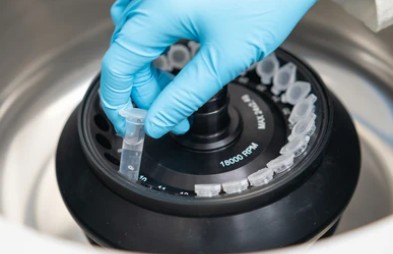Plasmid is the most commonly used carrier in molecular cloning, and the preparation of plasmid has become one of the most basic techniques in molecular cloning. The preparation of the plasmid DNA that has been transferred into the host cell mainly includes three steps: the cultivation of bacteria, the harvesting and lysing of cells, the separation and purification of plasmids.
Principle

Alkaline lysis extraction of plasmids utilizes topological differences between covalently closed circular plasmid DNA and linear chromosomal DNA fragments to separate them. In the narrow range of pH between 12.0 and 12.5, the linear DNA double helix structure unwinds and denatures. Under such conditions, although the hydrogen bond of the covalently closed circular plasmid DNA is broken, the two complementary strands are still intertwined with each other and tightly combined. When the pH was lowered by adding potassium acetate high-salt buffer at pH 4.8, the two complementary strands of the covalently closed circular plasmid DNA were rapidly and accurately renatured. However, the two complementary strands of linear chromosomal DNA have been completely separated from each other and cannot be renatured quickly and accurately. They are entangled to form a network structure. Through centrifugation, chromosomal DNA is precipitated together with unstable macromolecular RNA, protein-SDS complexes, etc., while plasmid DNA remains in the supernatant.
Reagent Preparation
- Solution a: 50 mmol/L glucose, 25 mmol/L Tris-HCl (pH 8.0), 10 mmol/L EDTA (pH 8.0). 1 mol/L Tris-HCl (pH 8.0) 12.5 mL, 0.5 mol/L EDTA (pH 8.0) 10 mL, glucose 4.730 g, add ddH2O to 500 mL. Autoclave at 121-126°C for 15 minutes and store at 4°C.
- Solution b: 0.2 mol/L NaOH, 1% SDS, 2 mol/L NaOH 1 mL, 10% SDS 1 mL, add ddH2O to 10 mL. Temporary configuration before use.
- Solution c: Potassium acetate (KAc) buffer, pH 4.8. 5 mol/L KAc 300 mL, glacial acetic acid 57.5 mL, add ddH2O to 500 mL. Store at 4°C for later use.
Procedures
- Pick a single colony grown on LB solid medium, inoculate it in 2.0 mL LB (containing corresponding antibiotics) liquid medium, culture at 37°C with shaking overnight (12-14 h).
- Take 1.5mL of the culture into a microcentrifuge tube, centrifuge at 8,000 g at room temperature for 1 min, discard the supernatant, and invert the centrifuge tube to drain the liquid as much as possible.
- Resuspend the bacterial pellet in 200 µL of pre-cooled solution a, shake vigorously to disperse and mix the bacteria.
- Add 300 µL of freshly prepared solution b, invert several times to mix (do not shake violently). Place the centrifuge tube on ice for 2-3 min to lyse the cell membrane (solution b is the lysate, so the bacterial solution in the centrifuge tube gradually becomes clear).
- Add 400 µL of pre-cooled solution c, invert the tube several times to mix well, and see white flocculent precipitate, which can be placed on ice for 10 min.
- Centrifuge at 12,000 g at 4°C for 10 min.
- Carefully remove the supernatant and put it into a new microcentrifuge tube, add 0.6 times the volume of pre-cooled isopropanol, mix well, place at -20°C for 20 min, and centrifuge at 12,000 g for 15 min at 4°C.
- Wash the precipitate with 1 mL of pre-cooled 70% ethanol for 1-2 times, centrifuge at 8,000 g at 4°C for 7 min, discard the supernatant, and dry the precipitate at room temperature.
- Dissolve the precipitate in 20 µL TE (containing RNase A 20 µg/mL), bathe in water at 37°C for 30 min to degrade RNA molecules, and store at -20°C for later use.
- Electrophoresis detection of plasmid DNA: Take 1-2 µL of the prepared plasmid DNA, add appropriate loading buffer, mix well and load the sample. A voltage of 1-5 V/cm is used to move the DNA molecule from the negative electrode to the positive electrode to a suitable position. Take out the gel and put it under ultraviolet light for detection and take pictures.
Note:
- The small-scale preparation of plasmid DNA by this lysis method has good reproducibility. If the extracted plasmid DNA cannot be cut by restriction endonucleases, it can be extracted again with phenol/chloroform to remove impurities and solve the problem.
- Fully suspend after adding solution a.
- After adding solution b, gently invert and mix well.
- Carefully aspirate the supernatant after phenol/chloroform extraction.
Related Services & Products
Our products/services are For Research Use Only. Not For Clinical Use!
 MEET US AT PLANT BIOLOGY 2024 June 22-26, 2024 Honolulu, Hl #309Learn More
MEET US AT PLANT BIOLOGY 2024 June 22-26, 2024 Honolulu, Hl #309Learn More
